Protective distal side-to-side neurorrhaphy in proximal nerve injury-an experimental study with rats
- PMID: 30746570
- PMCID: PMC6431300
- DOI: 10.1007/s00701-019-03835-2
Protective distal side-to-side neurorrhaphy in proximal nerve injury-an experimental study with rats
Abstract
Background: Side-to-side neurorrhaphy may protect the denervated end organ and preserve the initial connection with proximal stump. We examined the effect of protective side-to-side anastomosis on nerve and end organ regeneration in proximal nerve injury model.
Methods: The left common peroneal nerve of 24 Sprague Dawley rats was proximally transected. In groups B and C, side-to-side neurorrhaphy was performed distally between the peroneal and tibial nerves without (group B) and with (group C) partial donor nerve axotomy inside the epineural window. Group A served as an unprotected control. After 26 weeks, the proximal transection was repaired with end-to-end neurorrhaphy on all animals. Regeneration was followed during 12 weeks with the walk track analysis. Morphometric studies and wet muscle mass calculations were conducted at the end of the follow-up period.
Results: The results of the walk track analysis were significantly better in groups B and C compared to group A. Groups B and C showed significantly higher wet mass ratios of the tibialis anterior and extensor digitorum longus muscle compared to group A. Group C showed significantly higher morphometric values compared to group A. Group B reached higher values of the fibre count, fibre density, and percentage of the fibre area compared to group A.
Conclusions: Protective distal side-to-side neurorrhaphy reduced muscle atrophy and had an improving effect on the morphometric studies and walk track analysis. Distal side-to-side neurorrhaphy does not prevent the regenerating axons to grow from the proximal stump to achieve distal nerve stump.
Keywords: Chronic denervation; Nerve injury; Nerve regeneration; Nerve repair; Peripheral nerves; Side-to-side repair.
Conflict of interest statement
Conflict of interest
The authors declare that they have no conflict of interest.
Ethical approval
All procedures performed in studies involving animals were in accordance with the ethical standards of the institution or practice at which the studies were conducted. This article does not contain any studies with human participants performed by any of the authors.
Figures
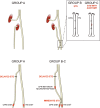

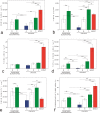

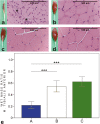
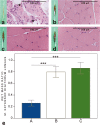
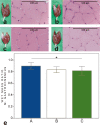
Similar articles
-
A rat study of the use of end-to-side peripheral nerve repair as a "babysitting" technique to reduce the deleterious effect of chronic denervation.J Neurosurg. 2018 Sep 14;131(2):622-632. doi: 10.3171/2018.3.JNS172357. J Neurosurg. 2018. PMID: 30215557
-
Can the Babysitter Procedure Improve Nerve Regeneration and Denervated Muscle Atrophy in the Treatment of Peripheral Nerve Injury?Plast Reconstr Surg. 2016 Jul;138(1):122-131. doi: 10.1097/PRS.0000000000002292. Plast Reconstr Surg. 2016. PMID: 27348644
-
Comparison of a distal end-to-side neurorrhaphy with a proximal-distal end-to-side neurorrhaphy: in a rat model.Eur J Orthop Surg Traumatol. 2015 Dec;25(8):1261-4. doi: 10.1007/s00590-015-1699-x. Epub 2015 Sep 7. Eur J Orthop Surg Traumatol. 2015. PMID: 26346962
-
End-to-side neurorrhaphy in peripheral nerves: Does it work?Hand Surg Rehabil. 2022 Feb;41(1):2-6. doi: 10.1016/j.hansur.2021.08.010. Epub 2021 Aug 28. Hand Surg Rehabil. 2022. PMID: 34464758
-
Does prophylactic decompression of distal nerves following nerve repair improve functional recovery? A systematic review.J Plast Reconstr Aesthet Surg. 2024 Apr;91:200-206. doi: 10.1016/j.bjps.2024.02.022. Epub 2024 Feb 7. J Plast Reconstr Aesthet Surg. 2024. PMID: 38422921
Cited by
-
Peroneal Nerve Repair with Cross-Bridge Ladder Technique: Parallel End-to-Side Neurorrhaphies.J Brachial Plex Peripher Nerve Inj. 2023 May 23;18(1):e21-e26. doi: 10.1055/s-0043-1768996. eCollection 2023 Jan. J Brachial Plex Peripher Nerve Inj. 2023. PMID: 37229420 Free PMC article.
-
Corneal neurotization for neurotrophic keratopathy: Review of surgical techniques and outcomes.Ocul Surf. 2021 Apr;20:163-172. doi: 10.1016/j.jtos.2021.02.010. Epub 2021 Feb 26. Ocul Surf. 2021. PMID: 33647470 Free PMC article. Review.
-
Insights on the Choice and Preparation of the Donor Nerve in Corneal Neurotization for Neurotrophic Keratopathy: A Narrative Review.J Clin Med. 2024 Apr 14;13(8):2268. doi: 10.3390/jcm13082268. J Clin Med. 2024. PMID: 38673540 Free PMC article. Review.
-
Partial enzyme digestion facilitates regeneration of crushed nerve in rat.Transl Neurosci. 2020 Aug 17;11(1):251-263. doi: 10.1515/tnsci-2020-0112. eCollection 2020. Transl Neurosci. 2020. PMID: 33335765 Free PMC article.
References
-
- Baltzer HMD, Woo AMD, Oh CMD, Moran SLMD. Comparison of ulnar intrinsic function following supercharge end-to-side anterior interosseous-to-ulnar motor nerve transfer: a matched cohort study of proximal ulnar nerve injury patients. Plast Reconstr Surg. 2016;138:1264–1272. doi: 10.1097/PRS.0000000000002747. - DOI - PubMed
Publication types
MeSH terms
LinkOut - more resources
Full Text Sources
Medical

